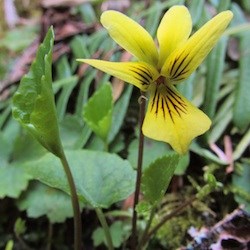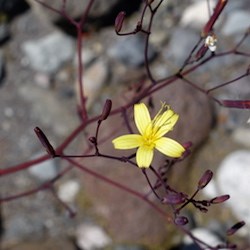|
Full resolution versions of wildflower photos available on flickr. 
NPS Photo Buttercup, CreepingRanunculus repens 
NPS Photo Buttercup, Small-floweredRanunculus uncinatus 
NPS Photo Canada GoldenrodSolidago lepida 
NPS Photo Large-leaved AvensGeum macrophyllum This plant has large fine-toothed basal leaves with three-lobed leaflets along the stem. Three to ten yellow flowers with five petals cluster at the top of the stem. Common along streams and the edges of woods, such as along trails and roads at lower elevations. 
NPS Photo Monkeyflower, ChickweedMimulus alsinoides 
NPS Photo Oregon-grape, CascadeBerberis nervosa This plant has stout stems with closely-spaced leaves with 11-19 toothed leaflets per leaf. Common in forests mostly below 3,000 feet (914 m). Produces small, tart, purple berries sometimes used for jelly.

NPS Photo Oregon-grape, Holly-leafBerberis aquifolium Less common than the related Cascade Oregon-grape, and more shrub-like. Holly-leaf Oregon-grape can be 3-9 feet (1-3 m) tall with spiny, dark green leaves very similar to the leaves of holly trees. Flowers are yellow and clustered. This plant can be found in the Longmire area or near the Nisqually Entrance. 
NPS Photo PinedropsPterospora andromedea 
NPS Photo Skunk CabbageLysichiton americanus Generally the first plant to bloom in spring, the bright yellow "flower" of the skunk cabbage is actually a modified bract, or leaf. The true flowers form a dense yellow-green spike that gives off a distinctive skunk-like smell. The glossy green basal leaves can grow to be up to 5 feet (1.5 m) long. Very common and easy to spot emerging from wet swampy ground throughout the park. 
NPS, Chris Roundtree Tiger LilyLilium columbianum Flowers bloom on tall, curved stalks so they hang downwards. Stalks can be up to 6.5 feet (2 m) long, though generally shorter. Narrow leaves encircle the lower portions of the stalk to form rings, or whorls. The leaves become scattered along the upper portion of the stalk. Grows in open woods on dryish ground, and along roadsides. 
NPS, Crow Vecchio Violet, EvergreenViola sempervirens Also known as trailing yellow violet, this tiny flower is common in moist forests and has heart- to kidney-shaped leaves. Stream or yellow wood violets (Viola glabella) look very similar and can also be found in the park. 
NPS Photo Violet, RoundleafViola orbiculata 
NPS Photo Wall LettuceMycelis muralis A nonnative plant commonly found along roadsides and open woods. Slender branched stems, overall about 12-28 inches (30-70 cm) tall, with loose clusters of five-petaled, yellow flowers. Leaves basal, with some clasping leaves along stem, and deeply lobed. Return to Wildflower Guide |
Last updated: April 1, 2025
